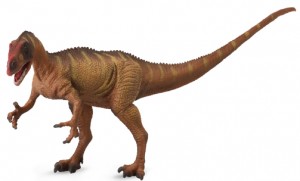Isle of Wight Where Dinosaurs Roamed
With the release of a map showing dinosaur discoveries made in the United Kingdom, the Isle of Wight, an island off Britain’s south coast has been declared the “dinosaur capital of Great Britain”. It is true that there have been some remarkable dinosaur fossil discoveries made on this island which is separated from the English mainland by a stretch of water called the Solent. The island has long since been known as “Dinosaur Isle” amongst palaeontologists and geologists who happen to frequent the southern part of the island exploring the Purbeck and Wealden strata of what is termed the Wessex Basin.
Dinosaur Capital
Iguanodontids, hypsilophodonts, sauropods, armoured dinosaurs and theropod meat-eating dinosaur fossils have all been found on the Isle of Wight. There are also numerous dinosaur footprints and tracks that can be seen on the foreshore at Chilton Chine and other parts of the coastline. Much has been made of the discovery of the fierce, meat-eating dinosaur known as Neovenator (Neovenator salerii). This theropod dinosaur is known from a single specimen discovered nearly thirty-five years ago. Neovenator means “New Hunter” and this dinosaur, tentatively assigned to the Carcharodontosauridae, may have measured more than 8 metres in length. It would have been dwarfed by some of the sauropods that shared its Early Cretaceous environment. Fossil discoveries made on the Isle of Wight indicate that there were brachiosaurids present and some of these long-necked herbivores could have weighed in excess of fifty tonnes.
A Model of the Fearsome Neovenator Dinosaur
Picture credit: Everything Dinosaur
Cretaceous Strata
The Cretaceous strata that makes up the southern part of the Isle of Wight is indeed important. It is not just dinosaur fossils that make this a significant location, palaeontologists have been able to painstakingly build up a picture of an palaeo-environment. In 2009 Doctor Steven Sweetman of the University of Portsmouth published a new, scientific paper outlining nearly fifty newly identified prehistoric vertebrates, whose fossils had been found eroding out of cliffs on the island. Amongst the new genera erected there were six new mammals, eight dinosaurs, including large, predatory dromaeosaurs (raptors) and fifteen new members of the Order Squamata (lizards and snakes).
During the Early Cretaceous (135 million years to 130 million years ago), the land we now know as the Isle of Wight formed part of an extensive flood plain that linked the continents of the Americas, Africa and Europe. More fossils are being found each year and palaeontologists are able to build up quite a detailed picture of the Cretaceous fauna and flora.
Not wishing to diminish the importance of the Isle of Wight, it is also worth remembering that a number of significant dinosaur finds have been made elsewhere in the British Isles. A considerable amount of Jurassic-aged dinosaur fossils have been found in North Yorkshire, the Isle of Skye has some amazing dinosaur tracks and fragmentary dinosaur bones, then there is the county of Surrey with its Baryonyx fossil discovery and our own personal favourite, the city of Bristol, with its Thecodontosaurus. The first fossils of Thecodontosaurus were found at a site just to the north of the city’s bustling centre, these fossils were found in 1834.
To read an article about Bristol honouring its very own dinosaur: Bristol Remembers its Very Own Triassic Dinosaur.
The Importance of the Isle of Wight
Then there are the megalosaurs and other dinosaurs from Oxfordshire, the Dorset Scelidosaurus, iguanodonts from the Wealden Formation outcrops of Kent and Sussex. In fact, there are a number of important locations in the UK in terms of the dinosaur fossils found at these sites. After all, the first dinosaurs to be ascribed to the newly erected Order Dinosauria were all species, whose fossils had been found in southern England.
For models and replicas of dinosaurs, including many dinosaurs associated with the Isle of Wight: Prehistoric Life Models (CollectA Age of Dinosaurs).
The Dinosaur Map of Britain
The research compiled by palaeontologists at the London Natural History Museum who tracked dinosaur fossil finds recorded over the last 336 years, was carried out as part of the publicity material for the television series “Primeval New World”, a spin-off from the earlier ITV programmes about a team of adventurers battling against worm holes that keep bringing prehistoric creatures back to the present day.







where’s Scelidosaurus and Thecodontosaurus?
The illustrated map is very superficial, we did point out that there were a number of genera missing, the map would be very much more detailed if all the dinosaur discoveries were plotted.